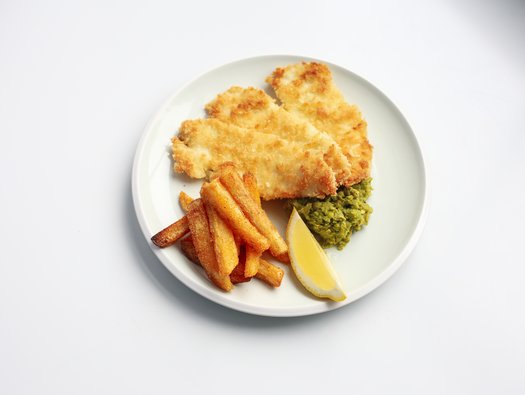Homemade fish and chips with mushy peas

This is a healthier way to enjoy a low potassium and low phosphate version of traditional fish and chips.

This is a healthier way to enjoy a low potassium and low phosphate version of traditional fish and chips.
600g plaice or sole fillet, skinless and boneless
2 eggs, beaten
85g plain flour
85g Japanese panko breadcrumbs
150ml vegetable oil
500g frozen peas
1 tsp chopped mint
1 tsp chopped tarragon
25g unsalted butter
25ml white wine vinegar
750g Maris Piper potatoes, peeled and cut into skinny chips
2 tablespoons vegetable oil
3 teaspoons fine cornmeal or polenta
1 teaspoon paprika
½ teaspoon garlic powder
1 lemon (optional)
Preheat the oven to 200°C / 180ᵒC fan /gas mark 6. Add the frozen peas to a pan of boiling water and simmer for 2 minutes. Drain and blender in a food processor. Add chopped herbs, butter and white wine vinegar and blend briefly, retaining some texture then set aside.
Bring a pan of water to the boil. Parboil the chips for 5 minutes, then drain and leave to cool. Pour the oil onto a baking tray and put in the oven for 3 minutes to heat up the oil.
Mix the cornmeal or polenta, paprika and garlic powder together in a bowl. Toss the chips in the mix, then tip on to the preheated tray. Shake well, and then cook for 30 minutes, shaking halfway through, until crisp and golden.
Cut the fish fillets into long thin strips. Set up three bowls, one with the flour, one with the beaten eggs and one with the breadcrumbs. Pass each strip through the flour, pat off any excess, then through the egg, and finally through the breadcrumbs. Place the breaded fish on a plate.
Heat 2 to 3 tablespoons of the oil in a shallow frying pan and fry the fish fillets in batches until golden. This should take approximately 2to 3 minutes on each side for each fish fillet, depending on thickness. Once cooked, place on kitchen paper to remove the excess oil.
Repeat step 5 until all the fish is cooked, wiping the pan with some kitchen roll between each batch to avoid the breadcrumbs burning. Serve the fish with the mushy peas, chips and a wedge of lemon.
The potato, breadcrumbs and flour are the main sources of carbohydrate in this main meal and the value has been provided for those who have been trained in insulin adjustment.
Parboiling the skinny chips before baking makes this dish suitable for anyone advised to reduce potassium in their diet. Keeping to the quantities listed in the ingredients and serving size, this is a low potassium recipe.
This recipe is also low in phosphate, however it does contain some phosphate, mainly provided by the fish, therefore if you have been prescribed a phosphate binder you should take as directed.
This dish is high in protein, therefore suitable for those advised to eat more protein such as those receiving dialysis.
Use gluten-free breadcrumbs and flour.
This dish is low in salt and no salt has been added during cooking. Traditionally, fish and chips will have salt and vinegar added when serving; however, it is advised that you avoid adding any salt to this meal. You can, however, add vinegar to your desired taste. If using tomato ketchup, you may want to opt for a reduced salt and sugar variety and use just a small amount.
Choose cheaper fillets of fish or fish on offer to reduce the cost. You can buy regular breadcrumbs or save money by making your own homemade breadcrumbs.
This dish is best eaten freshly cooked (this recipe can easily be halved for smaller groups).
For those with a transplant, it is best to purchase your fish pre-packaged.
Always lay the fish fillets in the oil away from you to avoid oil splashing.
By giving us your email address, you're giving us permission to send you the latest news from Kidney Care UK. Further information about how we protect and use your personal data is available in our Privacy policy. If you would like to change the way we communicate with you at any time please email [email protected]. You can unsubscribe at any time by using the link at the bottom of every email we send.